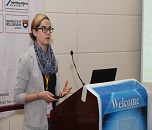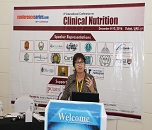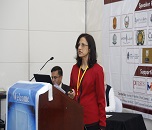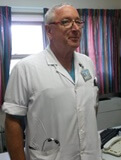Theme: Probiotics from Research to Market
Probiotics 2017
ConferenceSeries Ltd welcomes and invites all the participants from over the world to attend The 6th International Conference and Exhibition on Probiotics, Functional and Baby Foods to be held on October 02-03, 2017 in London, UK.
ConferenceSeries Ltd is the only scientific organization dedicated specifically to probiotics, bringing together scientists from all pertinent disciplines, including food science, microbiology, immunology, biochemistry, nutrition, molecular biology and medicine.
Probiotics 2017 highlights the theme “Probiotics from Research to Market: An Innovative Approach for Healthy Microbiota and Immune System” covering the future advancements in the field of Probiotics, Prebiotics, Nutrition and Food technology. Probiotics 2017 will be a landmark event for the establishment of collaborations and direct knowledge distribution scientists, researchers, academicians, educators, professionals, practitioners, nutritionists, dietitians, health professionals, sports nutritionists, physicians and students to exchange ideas, develop networks and get acknowledged about the latest research developments from the eminent figures working in the field of probiotics and to help discover the gaps still lying in the research field thereby providing a greater scope towards a better future with even better technologies and therapies for healing human health, animal health, plant health and aqauatic animal health and explore more diversified & innovative applications of probiotics.
Why to attend?
Probiotics 2017 is aimed to give an opportunity to the experts in the field of Food and Nutrition to examine most recent progressions and difficulties in the field. Probiotics 2017 is intended to give a fashionable dietitians stage to probiotics scientist, researchers, clinical nutritionists, enrolled, and different specialists and understudies working in the field to consider, trade sees and their encounters before an expansive global gathering of people. The gathering invites eminent scientists, researchers, Presidents, Delegates and expert professionals from the probiotics, food and nutrition industry to take part in the intuitive exploratory sessions, B2B gatherings and board talks.
Target audience
- Young and brilliant researchers
- Doctors
- Professionals
- Directors
- CEO’s
- Presidents
- Vice-presidents
- Professors
- Associate professors
- Assistant professors
- Dietitians
- Business Delegates from allied industries and companies
Summary
Probiotics are live microorganisms that are deliberated to have health benefits. Products which are sold as probiotics include foods (such as yogurt), dietary supplements, and products that are not used orally, such as skin creams. Popular probiotic products existing in the market include Amway Nutrilite Fiber, Herbalife Activated Fiber, HealthAid Acidophilus plus 4 Billion, Zenith Nutrition Probiotic Immune etc. Although more research is needed, there is an encouraging evidence that probiotics may help treat diarrhoea, especially following treatment with certain antibiotics, prevent and treat vaginal yeast infections and urinary tract infections, treat irritable bowel syndrome, speed treatment of certain intestinal infections, prevent or reduce the severity of colds and flu. Side effects due to probiotics are rare and most healthy adults can safely add foods that contain prebiotics and probiotics to their diets for better health and strong immune system.
Importance and scope
Probiotics food & beverages had the highest penetration in 2015, and this trend is expected to continue over the next eight years. Differentiated product portfolio and continued innovation in the sector are the primary reasons for this scenario.
Probiotics are finding acceptance in applications such as skin health. Development of proprietary formulation techniques is undertaken by companies to cater to customized needs.
Asia Pacific is expected to witness the highest growth of 7.7% over the next eight years. High population density and percentage of the youth population in countries such as India coupled with rising disposable income are expected to contribute to the market growth.
A major part of market share is held by very few companies. Companies are trying innovative techniques for customer engagement. Mergers & acquisitions are carried out to increase regional presence as well as market share.
Industry participants majorly include Chr. Hansen Holding A/S, Danone, Yakult Honsha Co., Ltd., Nestle, Probi AB, Danisco A/S, Lallemand Inc., and Arla Foods, Inc.
Probiotics Market
The global market of probiotics ingredients, supplements, and foods reached nearly $23.1 billion in 2012. This market is expected to grow to nearly $27.1 billion in 2013 and $36.7 billion in 2018 with a compound annual growth rate (CAGR) of 6.2% over the five-year period from 2013 to 2018 with further projections determined to exceed US $63 billion by 2022, driven by growing clinical evidence supporting the effectiveness of probiotics in general health maintenance and disease treatment. Probiotic therapy is growing in polularity in the treatment of lactose intolerance, lipid metabolism, oxalte metabolism, inflammatory bowel diseases (IBD), ulcerative colitits, irritable bowel syndrome (IBS), eczema, allergic rhinitis, infectious diarrhea, necrotizing enterocolitis and helicobacter pylori.Japan, Europe and the United States represents major market worldwide. Asia-pacific ranks as the fastest growing market with a CAGR of 12.7% over the analysis period. However, the probiotics market is still at a relatively novice stage, with lack of clarity on usage patterns among consumers, this is expected to play a critical role in market development over the next six years. Labeling regulations, especially in the U.S. and European Union, are also expected to have significant impact on market growth.
Food & beverages dominated the application market and accounted for over 80% of the total probiotics market, driven by growth of fermented meat, dairy, bakery, breakfast cereals, fats & oils, beverages, fish & eggs, meat, and soy products. Dietary supplements are expected to be the fastest growing application segment, at an estimated CAGR of 7.7% from 2012 to 2020.
"Food & beverages was the largest segment in 2015"
Probiotics food & beverages segment was the largest segment in 2015 and accounted for more than 85% of total revenue. This application includes dairy products, nondairy products, cereals, baked food, fermented meat products, and dry food probiotics.

Figure-1: Functional Food Market by Sector (% value)
"Human probiotics dominated the total demand in 2015"
Human probiotics accounted for more than 90% of total revenue in 2015. Growing health concerns and development of more effective probiotic strains is expected to aid the industry growth. Increasing standard of living, as well as disposable income in areas such as Asia Pacific, the Middle East and Africa as well as Central & South America, has been benefiting the overall market growth.
Animal feed bacteria are expected to show a steady growth over the next eight years. Companies have been trying to develop and market more effective probiotic strains aimed at improving health.
"Asia Pacific is expected to witness the highest growth from 2016 to 2024"
Asia Pacific dominated the global industry and accounted for more than 40%. Strong demand from countries such as India, China and Japan is the major contributing factor for this scenario. Rising population, growing awareness regarding probiotics usage and the strong presence of international players in the region are contributing to the market growth.
North America is expected to grow at an anticipated CAGR of 6.8% over the forecast period. Prevalent awareness regarding these product usages and rising preference for functional foods are the driving factors in the region. The Middle East & Africa and Central & South America are also expected to show modest growth over the forecast period.
"Companies investing heavily in R&D are a major market characteristic"
Major industry participants are investing heavily in R&D to develop more effective probiotic strains. The companies are also striving to develop products which find novel applications such as skin treatment. Third party R&D companies are employed to develop superior cultures to gain competitive advantage. High level of integration between raw material suppliers, manufacturers, suppliers and end users. Major industry participants include Danisco A/S, Danone, Chr Hansen, Nestle, Arla Foods, Inc., Probi and Lallemand Inc., S.A., China-Biotics, Inc., E. I. duPont de Nemours and Company, General Mills, Inc., Lifeway Foods, Inc., PROBI AB, BioGaia AB, Yakult Honsha Co., Ltd., Mother Dairy and Chr. Hansen. The growing popularity of probiotics worldwide has attracted many new players to participate in this market.
Key Segments of the Global Probiotic Market
A. Global probiotics market, by application
- Food and beverages
- Dietary supplements
- Animal feed
B. Global probiotics market, by end use
- Human probiotics
- Animal probiotics
C. Global probiotics market, by strain type
- Lactobacillus
- Streptococcus
- Bifidobacterium
- Yeast
- Spore Formers
- Others
Grand View Research has segmented the probiotics market on the basis of application, end use and region:
1. Global Probiotics Application Outlook (Revenue, USD Million, 2014 - 2024
A. ​Probiotics food & beverage
- Dairy products
- Non-dairy products
- Cereals
- Baked foods
- Fermented meat products
- Dry food probiotics
B. Probiotics dietary supplements
- Food supplements
- Nutritional supplements
- Specialty nutrients
- Infant formula
- Animal feed probiotics
2. Global Probiotics End Use Outlook (Revenue, USD Million, 2014 - 2024)
- Human probiotics
- Animal feed probiotics
3. Global Probiotics Regional Outlook (Revenue, USD Million, 2014- 2024)
North America
- U.S.
Europe
- Germany
- U.K
Asia Pacific
- China
- Japan
- India
Central & South America
- Brazil
Middle East & Africa
European Market
Europe is the second largest global market for probiotics after Asia-Pacific, cornering a share estimated to be 25% in 2014. Growth in demand for probiotics in the region is also likely to maintain a fast pace over the 2014-2020 analysis period. Germany and the United Kingdom are the two largest probiotics markets in Europe, with a combined share estimated at about 55% in 2014, with United Kingdom also expected to be the fastest growing. By product type, dietary supplements and functional foods & beverages are the largest, as well as the fastest growing segments.
Prevention and cure of disorders, such as lactose intolerance and inflammatory bowel disease are some of the benefits offered by probiotics, with rising health-consciousness levels and wider access to probiotic dietary supplements being the major factors sustaining growth. The past decade has been witness to the launch of more than 500 food & beverage probiotic products, which have garnered exceptional response in terms of acceptance. Some of the factors implicated in causes of digestive disorders, bloating and reduction in resistance to infections include poor and not-in-time diet, age and stress levels. Studies have revealed that consuming products enhanced with probiotics has been successful in moderating these conditions to a large extent.
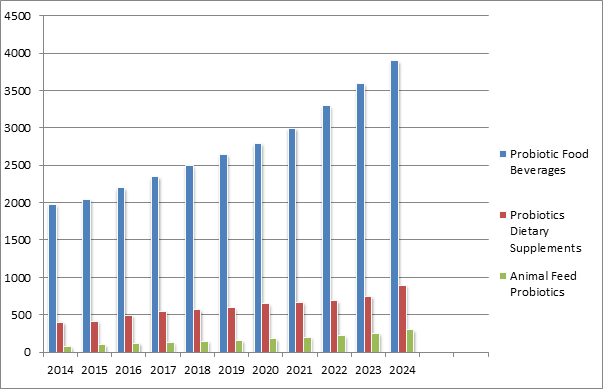
Figure-2: European Probiotics Market Revenue By Product, 2014 - 2024 (USD Million)
Why London, UK?
London is a leading global city in the arts, commerce, education, entertainment, fashion, finance, healthcare, media, professional services, research and development, tourism, and transport. It is one of the world's leading financial centres and has the fifth- or sixth-largest metropolitan area GDP in the world. London is a world cultural capital. It is the world's most-visited city as measured by international arrivals and has the world's largest city airport system measured by passenger traffic. London is the world's leading investment destination hosting more international retailers and ultra probiotics food & beverages had the highest penetration in 2015, and this trend is expected to continue over the next eight years. Differentiated product portfolio and continued innovation in the sector are the primary reasons for this scenario.
Industry participants majorly include Chr. Hansen Holding A/S, Danone, Yakult Honsha Co., Ltd., Nestle, Probi AB, Danisco A/S, Lallemand Inc., and Arla Foods, Inc. high-net-worth individuals than any other city. London's universities form the largest concentration of higher education institutes in Europe, and a 2014 report placed it first in the world university rankings. According to the report London also ranks first in the world in software, multimedia development and design, and shares first position in technology readiness.

Figure-3: Total Probiotics Market
List of Hospitals Research Centre:
London, UK
- The Institute of Cancer Research
- Evelina Children's Hospital - St Thomas' Hospital
- Barts Health NHS Trust
- St Mary's Hospital
- Royal London Hospital
- St. George's Hospital, London
- Barts Health NHS Trust
Worldwide
- Bedford Hospital
- Children’s Nutrition Research Centre
- Great Ormond Street Hospital for Children
- Human Nutrition Research Centre
- MRC Human Nutrition Research
- Nutrition Australia
- Nutrition Studies Research Group
- UK HealthCare
Major Probiotic Associations and Society
- Academy of Nutrition and Dietetics
- American Nutrition Association
- American Pregnancy Association
- American society of nutrition
- British Dietetic Association
- European Probiotic Association
- Global Alliance for Probiotics
- International Probiotic Association
- International Probiotic Association Europe
- International Scientific Association for Probiotics and Prebiotics
- Probiotic Association of India
- Society of Nutrition Education
Companies Associated with Probiotics:
- AB-biotics Bellaterra (Barcelona), Catalonia, Spai
- Atrium Innovations Montreal, Canada
- Bayer Basel, Switzerland
- Bifodan Hundested, Denmark
- Biocare Copenhagen, Denmark
- BIO-CAT Microbials Shakopee, MN, USA
- BIOSEARCH Granada, Andalusia, Spain
- BLIS Technologies Ltd South Dunedin, Otago, New Zealand
- Cell Biotech Gimpo, South Korea
- Centro Sperimentale del Latte s.r.l Zelo Buon Persico (Lodi), Italy
- Ch Deerland Enzymes Kennesaw, Georgia, USAinMax Medical Shanghai, China
- Chr Hansen Horsholm, Denmark
- Daflorn Sofia, Bulgaria
- DANONE Paris, France
- Essential Formulas Farmers Branch, TX, USA
- Fit-bioceuticals Alexandria, New South Wales, Australia
- Futureceuticals Momence, IL, USA
- i-Health Cromwell, Connecticut, USA
- Ildong Pharmaceutical Seoul, Korea
- Invictus Pharmanutricao Sao Paulo, Brazil
- Jarrow Formulas Los Angeles, CA, USA
- KeVita Inc. Oxnard, CA, USA
- KGK Clinical Trial Centers London, ON, Canada
- Kibow Biotech Inc Newtown Square, PA, USA
- Kyolic, Wakunaga of America Mission Viejo, CA, USA
- Lallemand Health Solutions Montreal, Canada
- Medlab Alexandria, Australia
Top Nutrition Universities in UK
- University of Surrey
- Queen's University, Belfast
- University of Leeds
- King's College London
- The University of Nottingham
- Coventry University
- Newcastle University
- University of Reading
- University of Hertfordshire
- Robert Gordon University
- University of Lincoln
Target Audience
- Students
- Researchers
- Nutritionist
- Dieticians
- Physicians
- Public Health Professionals
- Sports Nutritionists

Figure-4: Target audience for Probiotics
Glance at Market and Funding for Probiotics Research
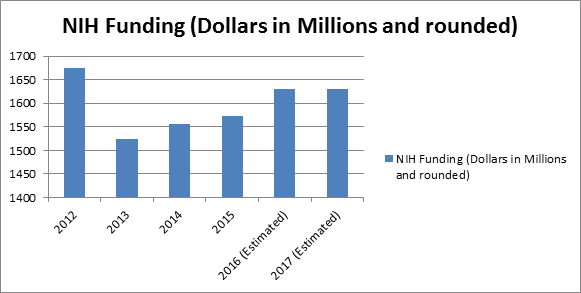
Figure-5: Projections Growth by next 5-10 years
Recent studies on Probiotics Market exhibit both the opportunities and forecasts during the period 2014-2022 during which the global probiotics market is expected to reach $57.4 billion by 2022, registering a CAGR of 7.7% during the forecast period, 2016-2022. Asia-Pacific is presently dominant in the market and is expected to be the leading contributor in global revenue, due to its high adoption of probiotic based food and beverages. Bacteria derived probiotics would dominate the market throughout the forecast period as yeast strains are still under research and testing phase and approvals from the Food and Drug Administration would take time to implement. By end use, the probiotics market is segmented into animal probiotics and human probiotics. Human probiotics is in the lead by contributing nearly 90% of global revenue in 2015 and is forecasted to grow at a fastest rate of 7.8% during the period 2016-2022. Growth in awareness about the probiotics benefits among the consumers through various means such as publications, fact sheets, and conferences would help to grow among human end users.
1. Probiotic Microorganism
The term “probiotic” remains undefined legally in many countries, and regulatory approaches differ among countries worldwide. Diverse categories encompass probiotic products, including: food, functional food, novel food, natural remedy (Denmark Sweden and Finland), natural health product (Canada), dietetic food (Italy), dietary supplement (USA), biotherapeutic and pharmaceuticals (probiotic pharmaceuticals are available in Canada, China, eastern European countries, France, Germany, Belgium, Austria and Italy). There is no official definition of probiotic in Japanese regulation, but several probiotic and prebiotic products have achieved FOSHU (foods for specialized health use) status, with health statements being approved by the Japanese Ministry of HealthWhile few studies have established the minimum effective dose of a probiotic to convey a physiological effect, probiotic-induced changes are rarely seen at daily doses of less than 108–10 colony forming units (cfu).24 However, one can only speculate as to how many probiotic cells reach target sites alive. Probiotic bacteria that are tolerant to acid stress would be expected to survive well during stomach passage. Genomic regions, identified through genome sequencing, that may help identify regions critical to the survival and functionality of commensal or probiotic organisms in their corresponding habitats might include: conserved versus distinct gene sets , genes resulting from recent horizontal transfer, altered GC content–islands/regions of adaptability.
Related Conferences: 9th International Congress on Nutrition & Health February 20-21, 2017 Berlin, Germany; 10th Annual Nutrition & Food Sciences Congress May 29-31, 2017 Osaka, Japan; 11th European Nutrition and Dietetics Conference June 29- July 01, 2017 Madrid, Spain; 10th International Conference on Clinical Diabetes, Diabetes care & Nutrition July 20-21, 2017 Chicago, USA; 13th World Congress on Advances in Natural Medicines, Nutraceuticals and Neurocognition, July 27-28, 2017, Rome, Italy 10th International Conference on Nutrition & Food Sciences May 29-31, 2017 Osaka, Japan; IPA World Congress + Probiota Americas June 07-09 San Francisco; The global nutraceutical event May 09 - 11 2017 Geneva Switzerland; ICPVM 2017: 19th International Conference on Probiotics in Veterinary Medicine April 8 - 9, 2017 Dubai, UAE; 5th World Congress on Targeting Microbiota October 2017 Paris, France; The International Scientific Conference on Probiotics and Prebiotics June 19– 22 June 2017 Budapest, Hungary; Probiotics Congress: USA October 3-4 2016 San Diego, USA; The 2nd Probiotics Congress: Asia Mar 1-2 2017 Hong Kong; ICPFPF 2017 : 19th International Conference on Probiotics, Functional and Pediatrics Foods July 10 - 11, 2017 Amsterdam, The Netherlands; ICPFF 2017 : 19th International Conference on Probiotics and Functional Foods March 9 - 10, 2017 Miami, USA.
2. Mechanisms of action of probiotics
Recent studies are providing new insight into the mechanisms by which the microbiota regulates the colonization and eradication of pathogens. Particularly revealing the ability of commensals to restrain pathogen growth by dictating the metabolic pathways that control the competition for limited nutrients in the intestine. Furthermore, inflammatory responses have profound effects on the growth of pathogens and certain commensal species. However, the relative contributions of each metabolic pathway and the commensal species involved remain poorly understood. In addition, little is known about how the inflammatory responses affect interactions between pathogens and commensals. There is a delicate balance in microbiota populations in the gut and disruption in this balance leads to dysbiosis and overgrowth of pathobionts leading to pathologic immune responses and disease. The identification and characterization of natural “competitors” that suppress the growth of pathogens and pathobionts may lead to the development of rational approaches to manage intestinal disease. There is also a clear role for host immunity in controlling microbiota populations. However, recent studies have challenged a critical role of innate recognition receptors in determining the composition of the gut microbiota. Further studies are needed to clarify the mechanism by which the host regulates the microbiota.
Related Conferences: 9th International Congress on Nutrition & Health February 20-21, 2017 Berlin, Germany; 10th Annual Nutrition & Food Sciences Congress May 29-31, 2017 Osaka, Japan; 11th European Nutrition and Dietetics Conference June 29- July 01, 2017 Madrid, Spain; 10th International Conference on Clinical Diabetes, Diabetes care & Nutrition July 20-21, 2017 Chicago, USA; 13th World Congress on Advances in Natural Medicines, Nutraceuticals and Neurocognition, July 27-28, 2017, Rome, Italy 10th International Conference on Nutrition & Food Sciences May 29-31, 2017 Osaka, Japan; IPA World Congress + Probiota Americas June 07-09 San Francisco; The global nutraceutical event May 09 - 11 2017 Geneva Switzerland; ICPVM 2017: 19th International Conference on Probiotics in Veterinary Medicine April 8 - 9, 2017 Dubai, UAE; 5th World Congress on Targeting Microbiota October 2017 Paris, France; The International Scientific Conference on Probiotics and Prebiotics June 19– 22 June 2017 Budapest, Hungary; Probiotics Congress: USA October 3-4 2016 San Diego, USA; The 2nd Probiotics Congress: Asia Mar 1-2 2017 Hong Kong; ICPFPF 2017 : 19th International Conference on Probiotics, Functional and Pediatrics Foods July 10 - 11, 2017 Amsterdam, The Netherlands; ICPFF 2017 : 19th International Conference on Probiotics and Functional Foods March 9 - 10, 2017 Miami, USA.
3. Probiotics and Health: A Clinical Perspective
Probiotics live microorganisms when administered in adequate amounts confer a health benefit on the host that have been studied for both human and animal applications, and worldwide research on this topic has accelerated in recent years. Administration of probiotics could be effective in the treatment of acute infectious diarrhoea in children and the prevention of antibiotic associated diarrhoea and nosocomial/community acquired diarrhoea. Encouraging evidence is also emerging for the effectiveness of probiotics in the prevention and management of pouchitis and paediatric atopic diseases, and the prevention of postoperative infections. There is also strong evidence that certain probiotic strains are able to enhance immune function, especially in subjects with less than adequate immune function such as the elderly. Efficacy of probiotics has been shown in the prevention of prevention of antibiotic-associated diarrhoea, sepsis associated with severe acute pancreatitis, improvement of lactose metabolism and cancers, the management of weight and lowering of blood cholesterol, but there is insufficient evidence to recommend them for use in other clinical conditions.
Related Conferences: 9th International Congress on Nutrition & Health February 20-21, 2017 Berlin, Germany; 10th Annual Nutrition & Food Sciences Congress May 29-31, 2017 Osaka, Japan; 11th European Nutrition and Dietetics Conference June 29- July 01, 2017 Madrid, Spain; 10th International Conference on Clinical Diabetes, Diabetes care & Nutrition July 20-21, 2017 Chicago, USA; 13th World Congress on Advances in Natural Medicines, Nutraceuticals and Neurocognition, July 27-28, 2017, Rome, Italy 10th International Conference on Nutrition & Food Sciences May 29-31, 2017 Osaka, Japan; IPA World Congress + Probiota Americas June 07-09 San Francisco; The global nutraceutical event May 09 - 11 2017 Geneva Switzerland; ICPVM 2017: 19th International Conference on Probiotics in Veterinary Medicine April 8 - 9, 2017 Dubai, UAE; 5th World Congress on Targeting Microbiota October 2017 Paris, France; The International Scientific Conference on Probiotics and Prebiotics June 19– 22 June 2017 Budapest, Hungary; Probiotics Congress: USA October 3-4 2016 San Diego, USA; The 2nd Probiotics Congress: Asia Mar 1-2 2017 Hong Kong; ICPFPF 2017 : 19th International Conference on Probiotics, Functional and Pediatrics Foods July 10 - 11, 2017 Amsterdam, The Netherlands; ICPFF 2017 : 19th International Conference on Probiotics and Functional Foods March 9 - 10, 2017 Miami, USA.
4. Probiotics in Gastroenterology
Gastroenterologists once defined gastrointestinal health as the absence of chronic disorder such as inflammatory bowel disease (IBD). However, this is too restrictive. The increasing frequency of digestive functional disorders, including non-ulcer dyspepsia and irritable bowel syndrome (IBS), justifies an enlargement of a definition that includes intestinal well-being and the overall impact on quality of life including reduction of disease risk. Some animal studies are required to investigate this concept. The intestinal microflora has been linked with a number of intestinal diseases including colon cancer, (IBS) and IBD however few details of their involvement have been elucidated. Since colon cancer and IBD can lead to extreme therapeutic approaches, including surgical excision, clarification of the role of the microflora in these diseases may significantly reduce morbidity.
Related Conferences: 9th International Congress on Nutrition & Health February 20-21, 2017 Berlin, Germany; 10th Annual Nutrition & Food Sciences Congress May 29-31, 2017 Osaka, Japan; 11th European Nutrition and Dietetics Conference June 29- July 01, 2017 Madrid, Spain; 10th International Conference on Clinical Diabetes, Diabetes care & Nutrition July 20-21, 2017 Chicago, USA; 13th World Congress on Advances in Natural Medicines, Nutraceuticals and Neurocognition, July 27-28, 2017, Rome, Italy 10th International Conference on Nutrition & Food Sciences May 29-31, 2017 Osaka, Japan; IPA World Congress + Probiota Americas June 07-09 San Francisco; The global nutraceutical event May 09 - 11 2017 Geneva Switzerland; ICPVM 2017: 19th International Conference on Probiotics in Veterinary Medicine April 8 - 9, 2017 Dubai, UAE; 5th World Congress on Targeting Microbiota October 2017 Paris, France; The International Scientific Conference on Probiotics and Prebiotics June 19– 22 June 2017 Budapest, Hungary; Probiotics Congress: USA October 3-4 2016 San Diego, USA; The 2nd Probiotics Congress: Asia Mar 1-2 2017 Hong Kong; ICPFPF 2017 : 19th International Conference on Probiotics, Functional and Pediatrics Foods July 10 - 11, 2017 Amsterdam, The Netherlands; ICPFF 2017 : 19th International Conference on Probiotics and Functional Foods March 9 - 10, 2017 Miami, USA.
5. Probiotics in Pediatrics
Presenting global evidence for their utility in children, Prof. Sherman illustrated that evidence through randomized controlled trails have demonstrated that certain probiotic strains are more effective than placebo in a variety of conditions affecting the gastrointestinal tract. Multiple meta-analyses indicate effectiveness in reducing the duration of acute enteritis in pre-schoolers and in reducing the frequency of necrotizing enterocolitis in pre-term babies. As probiotics exist naturally in some foods and are also available as dietary supplements in powder, capsule, and tablet forms. In 2002, the industry secured FDA designation of specific strains of B. lactis and Streptococcus thermophilus as substances generally recognized as safe (GRAS) in milk-based formulas for infants aged 4 months and older. Most probiotic bacteria are similar to the beneficial bacteria that occur naturally in the gut, including those of the Lactobacillus species (eg, L. acidophilus). Infants acquire other bacteria during their first months, mainly those of the Bifidobacterium and Enterobacter species. Bifidobacterium species dominate in the gut of breast-fed infants, whereas Enterobacter microbes dominate in bottle-fed infants. This difference in species, which has been identified as key to breast-fed infants’ superior immunity to many infections, has spurred much of the medical and pediatric communities’ interest in probiotics. Infant formula manufacturers have also taken interest.
Related Conferences: 9th International Congress on Nutrition & Health February 20-21, 2017 Berlin, Germany; 10th Annual Nutrition & Food Sciences Congress May 29-31, 2017 Osaka, Japan; 11th European Nutrition and Dietetics Conference June 29- July 01, 2017 Madrid, Spain; 10th International Conference on Clinical Diabetes, Diabetes care & Nutrition July 20-21, 2017 Chicago, USA; 13th World Congress on Advances in Natural Medicines, Nutraceuticals and Neurocognition, July 27-28, 2017, Rome, Italy 10th International Conference on Nutrition & Food Sciences May 29-31, 2017 Osaka, Japan; IPA World Congress + Probiota Americas June 07-09 San Francisco; The global nutraceutical event May 09 - 11 2017 Geneva Switzerland; ICPVM 2017: 19th International Conference on Probiotics in Veterinary Medicine April 8 - 9, 2017 Dubai, UAE; 5th World Congress on Targeting Microbiota October 2017 Paris, France; The International Scientific Conference on Probiotics and Prebiotics June 19– 22 June 2017 Budapest, Hungary; Probiotics Congress: USA October 3-4 2016 San Diego, USA; The 2nd Probiotics Congress: Asia Mar 1-2 2017 Hong Kong; ICPFPF 2017 : 19th International Conference on Probiotics, Functional and Pediatrics Foods July 10 - 11, 2017 Amsterdam, The Netherlands; ICPFF 2017 : 19th International Conference on Probiotics and Functional Foods March 9 - 10, 2017 Miami, USA.
6. Probiotics in Animal Health
The use of probiotics for farm animals has increased considerably over the last 15 years. Probiotics are defined as live microorganisms which can confer a health benefit for the host when administered in appropriate and regular quantities. Once ingested, the probiotic microorganisms can modulate the balance and activities of the gastrointestinal microbiota, whose role is fundamental to gut homeostasis. It has been demonstrated that numerous factors, such as dietary and management constraints, can strongly affect the structure and activities of the gut microbial communities, leading to impaired health and performance in livestock animals. Probiotic microorganisms, which benefit from a ‘natural image’, can expect a promising future in animal nutrition. Controlled research studies demonstrate that they can positively balance gastrointestinal microbiota, and thereby improve animal production and health. However, care must be taken in the way that the probiotic candidate-strains are selected. Better knowledge of the structure and activities of the gut microbiota, functional interactions between gut microbes and interrelationships between microbes and host cells represent a fundamental aspect of future probiotic research. In this context new ‘omic’ technologies will be very helpful to better characterize and understand the effects of probiotics on the balance of the gastrointestinal microbiota. It will be possible to select more powerful or targeted strains on a scientific basis and follow their behaviour in the host animal. Thanks to these techniques, which are complimentary to anaerobic culture methods and gnotobiotic animal or cellular models, probiotic research has had, and will also certainly have in the future, a very important place in the improvement of animal health and nutrition.
Related Conferences: 9th International Congress on Nutrition & Health February 20-21, 2017 Berlin, Germany; 10th Annual Nutrition & Food Sciences Congress May 29-31, 2017 Osaka, Japan; 11th European Nutrition and Dietetics Conference June 29- July 01, 2017 Madrid, Spain; 10th International Conference on Clinical Diabetes, Diabetes care & Nutrition July 20-21, 2017 Chicago, USA; 13th World Congress on Advances in Natural Medicines, Nutraceuticals and Neurocognition, July 27-28, 2017, Rome, Italy 10th International Conference on Nutrition & Food Sciences May 29-31, 2017 Osaka, Japan; IPA World Congress + Probiota Americas June 07-09 San Francisco; The global nutraceutical event May 09 - 11 2017 Geneva Switzerland; ICPVM 2017: 19th International Conference on Probiotics in Veterinary Medicine April 8 - 9, 2017 Dubai, UAE; 5th World Congress on Targeting Microbiota October 2017 Paris, France; The International Scientific Conference on Probiotics and Prebiotics June 19– 22 June 2017 Budapest, Hungary; Probiotics Congress: USA October 3-4 2016 San Diego, USA; The 2nd Probiotics Congress: Asia Mar 1-2 2017 Hong Kong; ICPFPF 2017 : 19th International Conference on Probiotics, Functional and Pediatrics Foods July 10 - 11, 2017 Amsterdam, The Netherlands; ICPFF 2017 : 19th International Conference on Probiotics and Functional Foods March 9 - 10, 2017 Miami, USA.
7. Plant Probiotics
The increasing interest in the preservation of the environment and the health of consumers is changing production methods and food consumption habits. Consumers increasingly demand safe functional foods that have beneficial properties for health mainly focused on the protection against carcinogenesis and oxidative processes. The consumption of fresh fruits and vegetables containing bioactive compounds has increased considerably in recent years and many studies have been carried out on the potential benefits of such compounds in different aspects of human health. At the same time, there has been a strong increase in studies addressing the benefits of biofertilization for plants and the environment. In this sense plant promoting rhizobacteria (PGPR) able to colonize the inside of plants tissues are especially interesting. These beneficial microorganisms are plant probiotics and promote the plant growth through different direct mechanisms such as nitrogen fixation, phosphate solubilization, and the production of different compounds such as phytohormones or indirect mechanisms such as the production of siderophores. To achieve both aims, the promotion of plant growth and the benefits for human health, it is necessary to use non-pathogenic microorganisms in biofertilization schemes.
Related Conferences: 9th International Congress on Nutrition & Health February 20-21, 2017 Berlin, Germany; 10th Annual Nutrition & Food Sciences Congress May 29-31, 2017 Osaka, Japan; 11th European Nutrition and Dietetics Conference June 29- July 01, 2017 Madrid, Spain; 10th International Conference on Clinical Diabetes, Diabetes care & Nutrition July 20-21, 2017 Chicago, USA; 13th World Congress on Advances in Natural Medicines, Nutraceuticals and Neurocognition, July 27-28, 2017, Rome, Italy 10th International Conference on Nutrition & Food Sciences May 29-31, 2017 Osaka, Japan; IPA World Congress + Probiota Americas June 07-09 San Francisco; The global nutraceutical event May 09 - 11 2017 Geneva Switzerland; ICPVM 2017: 19th International Conference on Probiotics in Veterinary Medicine April 8 - 9, 2017 Dubai, UAE; 5th World Congress on Targeting Microbiota October 2017 Paris, France; The International Scientific Conference on Probiotics and Prebiotics June 19– 22 June 2017 Budapest, Hungary; Probiotics Congress: USA October 3-4 2016 San Diego, USA; The 2nd Probiotics Congress: Asia Mar 1-2 2017 Hong Kong; ICPFPF 2017 : 19th International Conference on Probiotics, Functional and Pediatrics Foods July 10 - 11, 2017 Amsterdam, The Netherlands; ICPFF 2017 : 19th International Conference on Probiotics and Functional Foods March 9 - 10, 2017 Miami, USA.
8. Probiotics in Aquaculture
Aquaculture is the world's fastest growing food production sector. However, fish culture is currently suffering from serious losses due to infectious diseases. The use of antimicrobial drugs, pesticides and disinfectant in aquaculture disease prevention and growth promotion has led to the evolution of resistant strains of bacteria. Thus, the research into the use of probiotics for aquaculture is increasing with the demand for environment – friendly sustainable aquaculture. The benefits of such supplements include improved feed value, enzymatic contribution to digestion, inhibition of pathogenic microorganisms, anti-mutagenic and anti-carcinogenic activity, and increased immune response. These probiotics are harmless bacteria that help the well-being of the host animal and contribute, directly or indirectly to protect the host animal against harmful bacterial pathogens. The use of probiotics in aquaculture has just begun, due to the fact that gastrointestinal microbiota of aquatic organisms has been poorly characterized, and their effects are not studied extensively.
Related Conferences: 9th International Congress on Nutrition & Health February 20-21, 2017 Berlin, Germany; 10th Annual Nutrition & Food Sciences Congress May 29-31, 2017 Osaka, Japan; 11th European Nutrition and Dietetics Conference June 29- July 01, 2017 Madrid, Spain; 10th International Conference on Clinical Diabetes, Diabetes care & Nutrition July 20-21, 2017 Chicago, USA; 13th World Congress on Advances in Natural Medicines, Nutraceuticals and Neurocognition, July 27-28, 2017, Rome, Italy 10th International Conference on Nutrition & Food Sciences May 29-31, 2017 Osaka, Japan; IPA World Congress + Probiota Americas June 07-09 San Francisco; The global nutraceutical event May 09 - 11 2017 Geneva Switzerland; ICPVM 2017: 19th International Conference on Probiotics in Veterinary Medicine April 8 - 9, 2017 Dubai, UAE; 5th World Congress on Targeting Microbiota October 2017 Paris, France; The International Scientific Conference on Probiotics and Prebiotics June 19– 22 June 2017 Budapest, Hungary; Probiotics Congress: USA October 3-4 2016 San Diego, USA; The 2nd Probiotics Congress: Asia Mar 1-2 2017 Hong Kong; ICPFPF 2017 : 19th International Conference on Probiotics, Functional and Pediatrics Foods July 10 - 11, 2017 Amsterdam, The Netherlands; ICPFF 2017 : 19th International Conference on Probiotics and Functional Foods March 9 - 10, 2017 Miami, USA.
9. Probioceuticals: Probiotic- Derived Factors
Probiotic-derived factors have been described as capable of exerting probiotic activities through various mechanisms. However, it is important to distinguish between the concept of probiotic, which is necessarily based on the ingestion of live microorganisms, and the concept of microorganism-derived bioactive compounds that may have useful applications in nutrition and medicine. Bioactive compounds of bacterial or yeast origin, (antibiotics, for example), have been utilized in medicine for decades. Although there are many bacteria-derived products capable of inducing a health benefit, the concept of probiotic is only attributed to microorganisms administered as viable forms, providing the opportunity for a symbiotic relationship between the host, and resident, or in-transit, microorganisms. Secreted probiotic factors, such as reuterin from Lactobacillus reuteri, have been reported to inhibit adhesion and viability of known enteric pathogens, suggesting that probiotic supernatants could be a rich source of new antipathogenic compounds. In an in vitro study in human gastric epithelial cells, spent culture supernatants from certain lactic acid producing bacteria inhibited the growth and attachment of Helicobacter pylori. Roselli et al. demonstrated that supernatants of Bifidobacterium animalis MB5 and Lactobacillus GG could inhibit adhesion of E. coli K88 to Caco-2 cells, with the supernatant exerting identical beneficial effects following protease digestion, suggesting that proteins were not the active constituent.
Related Conferences: 9th International Congress on Nutrition & Health February 20-21, 2017 Berlin, Germany; 10th Annual Nutrition & Food Sciences Congress May 29-31, 2017 Osaka, Japan; 11th European Nutrition and Dietetics Conference June 29- July 01, 2017 Madrid, Spain; 10th International Conference on Clinical Diabetes, Diabetes care & Nutrition July 20-21, 2017 Chicago, USA; 13th World Congress on Advances in Natural Medicines, Nutraceuticals and Neurocognition, July 27-28, 2017, Rome, Italy 10th International Conference on Nutrition & Food Sciences May 29-31, 2017 Osaka, Japan; IPA World Congress + Probiota Americas June 07-09 San Francisco; The global nutraceutical event May 09 - 11 2017 Geneva Switzerland; ICPVM 2017: 19th International Conference on Probiotics in Veterinary Medicine April 8 - 9, 2017 Dubai, UAE; 5th World Congress on Targeting Microbiota October 2017 Paris, France; The International Scientific Conference on Probiotics and Prebiotics June 19– 22 June 2017 Budapest, Hungary; Probiotics Congress: USA October 3-4 2016 San Diego, USA; The 2nd Probiotics Congress: Asia Mar 1-2 2017 Hong Kong; ICPFPF 2017 : 19th International Conference on Probiotics, Functional and Pediatrics Foods July 10 - 11, 2017 Amsterdam, The Netherlands; ICPFF 2017 : 19th International Conference on Probiotics and Functional Foods March 9 - 10, 2017 Miami, USA.
10. Probiotic Delivery Systems
Since probiotic-containing products in general do not require Food and Drug Administration approval, they are commonly available in the market in various food formats such as fermented milk, cheese, yogurt and juice. In recent years, probiotics have been extensively studied as a treatment option of various diseases such as obesity, diabetes, cancer, human immunodeficiency virus infection, irritable bowel syndrome. Due to probiotic’s vulnerability to several environmental factors such as temperature and pH, maintaining the viability of probiotics has long been a hurdle to develop successful probiotic delivery systems. Hence to overcome these hurdles in probiotic delivery methods like encapsulation of materials and recent probiotic delivery technologies are being commonly used. Microencapsulation technologies have been developed to protect the bacteria from damage caused by external environment. By the introduction of a straw delivery system containing a dry form of the probiotic bacterium beverage manufacturers can now provide it to the consumer. In addition, viable spores of a spore forming probiotic are available in the market offering advantages during processing. In the same time, the potential of antibiotics’ substances with antimicrobial properties production by bifidobacteria is being explored in order to be applied in the food area.
Related Conferences: 9th International Congress on Nutrition & Health February 20-21, 2017 Berlin, Germany; 10th Annual Nutrition & Food Sciences Congress May 29-31, 2017 Osaka, Japan; 11th European Nutrition and Dietetics Conference June 29- July 01, 2017 Madrid, Spain; 10th International Conference on Clinical Diabetes, Diabetes care & Nutrition July 20-21, 2017 Chicago, USA; 13th World Congress on Advances in Natural Medicines, Nutraceuticals and Neurocognition, July 27-28, 2017, Rome, Italy 10th International Conference on Nutrition & Food Sciences May 29-31, 2017 Osaka, Japan; IPA World Congress + Probiota Americas June 07-09 San Francisco; The global nutraceutical event May 09 - 11 2017 Geneva Switzerland; ICPVM 2017: 19th International Conference on Probiotics in Veterinary Medicine April 8 - 9, 2017 Dubai, UAE; 5th World Congress on Targeting Microbiota October 2017 Paris, France; The International Scientific Conference on Probiotics and Prebiotics June 19– 22 June 2017 Budapest, Hungary; Probiotics Congress: USA October 3-4 2016 San Diego, USA; The 2nd Probiotics Congress: Asia Mar 1-2 2017 Hong Kong; ICPFPF 2017 : 19th International Conference on Probiotics, Functional and Pediatrics Foods July 10 - 11, 2017 Amsterdam, The Netherlands; ICPFF 2017 : 19th International Conference on Probiotics and Functional Foods March 9 - 10, 2017 Miami, USA.
11. Traditional Therapies of Probiotics
There is an increasing scientific and commercial interest in the use of beneficial microorganisms, or "probiotics," for the prevention and treatment of disease. The microorganisms most frequently used as probiotic agents are lactic-acid bacteria such as Lactobacillus rhamnosus GG (LGG), which has been extensively studied in recent literature. Multiple mechanisms of action have been postulated, including lactose digestion, production of antimicrobial agents, competition for space or nutrients, and immunomodulation. Studies of pediatric diarrhoea show substantial evidence of clinical benefits from probiotic therapy in patients with viral gastroenteritis, and data on LGG treatment for Clostridium difficile diarrhoea appear promising. However, data to support use of probiotics for prevention of traveler's diarrhoea are more limited. New research suggests potential applications in vaccine development and prevention of sexually transmitted diseases. Further studies are needed to take full advantage of this traditional medical approach and to apply it to the infectious diseases.
Related Conferences: 9th International Congress on Nutrition & Health February 20-21, 2017 Berlin, Germany; 10th Annual Nutrition & Food Sciences Congress May 29-31, 2017 Osaka, Japan; 11th European Nutrition and Dietetics Conference June 29- July 01, 2017 Madrid, Spain; 10th International Conference on Clinical Diabetes, Diabetes care & Nutrition July 20-21, 2017 Chicago, USA; 13th World Congress on Advances in Natural Medicines, Nutraceuticals and Neurocognition, July 27-28, 2017, Rome, Italy 10th International Conference on Nutrition & Food Sciences May 29-31, 2017 Osaka, Japan; IPA World Congress + Probiota Americas June 07-09 San Francisco; The global nutraceutical event May 09 - 11 2017 Geneva Switzerland; ICPVM 2017: 19th International Conference on Probiotics in Veterinary Medicine April 8 - 9, 2017 Dubai, UAE; 5th World Congress on Targeting Microbiota October 2017 Paris, France; The International Scientific Conference on Probiotics and Prebiotics June 19– 22 June 2017 Budapest, Hungary; Probiotics Congress: USA October 3-4 2016 San Diego, USA; The 2nd Probiotics Congress: Asia Mar 1-2 2017 Hong Kong; ICPFPF 2017 : 19th International Conference on Probiotics, Functional and Pediatrics Foods July 10 - 11, 2017 Amsterdam, The Netherlands; ICPFF 2017 : 19th International Conference on Probiotics and Functional Foods March 9 - 10, 2017 Miami, USA.
12. Functional Foods
Overwhelming evidence from epidemiological, in vivo, in vitro, and clinical trial data indicates that a plant-based diet can reduce the risk of chronic disease, particularly cancer. In 1992, a review of 200 epidemiological studies showed that cancer risk in people consuming diets high in fruits and vegetables was only one-half that in those consuming few of these foods. It is now clear that there are components in a plant-based diet other than traditional nutrients that can reduce cancer risk. Functional foods containing physiologically-active components, either from plant or animal sources, may enhance health. It should be stressed, however, that functional foods are not a magic bullet or universal panacea for poor health habits. There are no “good” or “bad” foods, but there are good or bad diets. The range of food products containing probiotic strains is wide and still growing. The main products existing in the market are dairy-based ones including fermented milks, cheese, ice cream, buttermilk, milk powder, and yogurts, the latter accounting for the largest share of sales. The functional food market is expanding, especially in Japan its birthplace with further growth prospects in Europe and the United States and in most countries the largest share of its products is held by probiotics. Common foods containing probiotics include fermented and unfermented milk, miso, tempeh, and some juices, smoothies, nutrition bars, and soy drinks. The most common strains found in yogurt are L. bulgaricus and S. thermophilus.
13. Beneficial aspects of Prebiotics
Prebiotics are non-digestible, fermentable carbohydrates and fibers, such as inulin-type frucans and galacto-oligosaccharides, which exhibit health promoting properties to host through selective stimulation of growth and/or activities of a limited number of bacteria (i.e., probiotics). Human milk contains substantial quantities of prebiotics. There is a paucity of Random Clinical Trials examining prebiotics in children, showing that there may be some long-term benefit of prebiotics for the prevention of atopic eczema and common infections in healthy infants for which confirmatory well-designed clinical research studies are necessary.
Related Conferences: 9th International Congress on Nutrition & Health February 20-21, 2017 Berlin, Germany; 10th Annual Nutrition & Food Sciences Congress May 29-31, 2017 Osaka, Japan; 11th European Nutrition and Dietetics Conference June 29- July 01, 2017 Madrid, Spain; 10th International Conference on Clinical Diabetes, Diabetes care & Nutrition July 20-21, 2017 Chicago, USA; 13th World Congress on Advances in Natural Medicines, Nutraceuticals and Neurocognition, July 27-28, 2017, Rome, Italy 10th International Conference on Nutrition & Food Sciences May 29-31, 2017 Osaka, Japan; IPA World Congress + Probiota Americas June 07-09 San Francisco; The global nutraceutical event May 09 - 11 2017 Geneva Switzerland; ICPVM 2017: 19th International Conference on Probiotics in Veterinary Medicine April 8 - 9, 2017 Dubai, UAE; 5th World Congress on Targeting Microbiota October 2017 Paris, France; The International Scientific Conference on Probiotics and Prebiotics June 19– 22 June 207 Budapest, Hungary; Probiotics Congress: USA October 3-4 2016 San Diego, USA; The 2nd Probiotics Congress: Asia Mar 1-2 2017 Hong Kong; ICPFPF 2017 : 19th International Conference on Probiotics, Functional and Pediatrics Foods July 10 - 11, 2017 Amsterdam, The Netherlands; ICPFF 2017 : 19th International Conference on Probiotics and Functional Foods March 9 - 10, 2017 Miami, USA.
14. Regulation and Product Development
Depending on intended use of a probiotic (drug vs. dietary supplement), regulatory requirements differ greatly. If a probiotic is intended for use as a drug, then it must undergo the regulatory process as a drug, which is similar to that of any new therapeutic agent. Despite the promising evidence, the role of probiotics in human health as well as the safety of their application should be further investigated as the current knowledge of the characteristics that are necessary for their functionality in the gut is not complete. The factors that must be addressed in evaluating the effectiveness of the incorporation of the probiotic strains into such products are, besides safety, the compatibility of the product with the microorganism and the maintenance of its viability through food processing, packaging, and storage conditions. The product’s pH for instance is a significant factor determining the incorporated probiotic’s survival and growth, and this is one of the reasons why soft cheeses seem to have a number of advantages over yoghurt as delivery systems for viable probiotics to the gastrointestinal tract. Current technological innovations provide ways to overcome probiotic stability and viability issues offering new options for their incorporation in new media and subsequent satisfaction of the increasing consumer demand. The safety profile of a potential probiotic strain is of critical importance in the selection process. This testing should include the determination of strain resistance to a wide variety of common classes of antibiotics such as tetracyclines, quinolones and macrolides and subsequent confirmation of non-transmission of drug resistance genes or virulence plasmids. Evaluation should also take the end-product formulation into consideration because this can induce adverse effects in some subjects or negate the positive effects altogether. A better understanding of the potential mechanisms whereby probiotic organisms might cause adverse effects will help to develop effective assays that predict which strains might not be suitable for use in probiotic products.
Related Conferences: 9th International Congress on Nutrition & Health February 20-21, 2017 Berlin, Germany; 10th Annual Nutrition & Food Sciences Congress May 29-31, 2017 Osaka, Japan; 11th European Nutrition and Dietetics Conference June 29- July 01, 2017 Madrid, Spain; 10th International Conference on Clinical Diabetes, Diabetes care & Nutrition July 20-21, 2017 Chicago, USA; 13th World Congress on Advances in Natural Medicines, Nutraceuticals and Neurocognition, July 27-28, 2017, Rome, Italy 10th International Conference on Nutrition & Food Sciences May 29-31, 2017 Osaka, Japan; IPA World Congress + Probiota Americas June 07-09 San Francisco; The global nutraceutical event May 09 - 11 2017 Geneva Switzerland; ICPVM 2017: 19th International Conference on Probiotics in Veterinary Medicine April 8 - 9, 2017 Dubai, UAE; 5th World Congress on Targeting Microbiota October 2017 Paris, France; The International Scientific Conference on Probiotics and Prebiotics June 19– 22 June 2017 Budapest, Hungary; Probiotics Congress: USA October 3-4 2016 San Diego, USA; The 2nd Probiotics Congress: Asia Mar 1-2 2017 Hong Kong; ICPFPF 2017 : 19th International Conference on Probiotics, Functional and Pediatrics Foods July 10 - 11, 2017 Amsterdam, The Netherlands; ICPFF 2017 : 19th International Conference on Probiotics and Functional Foods March 9 - 10, 2017 Miami, USA.
15. Safety of Probiotic Organisms
Probiotics have been used safely for years. Safety outcomes are inconsistently reported in published clinical trials. In 2011, a report released by the Agency for Healthcare Research and Quality concluded that, although the existing probiotic clinical trials reveal no evidence of increased risk, "the current literature is not well equipped to answer questions on the safety of probiotics in intervention studies with confidence." Critics point out that the preponderance of evidence, including the long history of safe probiotic use as well as data from clinical trials, and animal and in vitro studies all support the assumption that probiotics are generally safe for most populations. Theoretical risks have been described in case reports, clinical trial results and experimental models, include systemic infections, deleterious metabolic activities, excessive immune stimulation in susceptible individuals, gene transfer and gastrointestinal side effects. More research is needed to properly describe the incidence and severity of adverse events related to probiotics.
Related Conferences: 9th International Congress on Nutrition & Health February 20-21, 2017 Berlin, Germany; 10th Annual Nutrition & Food Sciences Congress May 29-31, 2017 Osaka, Japan; 11th European Nutrition and Dietetics Conference June 29- July 01, 2017 Madrid, Spain; 10th International Conference on Clinical Diabetes, Diabetes care & Nutrition July 20-21, 2017 Chicago, USA; 13th World Congress on Advances in Natural Medicines, Nutraceuticals and Neurocognition, July 27-28, 2017, Rome, Italy 10th International Conference on Nutrition & Food Sciences May 29-31, 2017 Osaka, Japan; IPA World Congress + Probiota Americas June 07-09 San Francisco; The global nutraceutical event May 09 - 11 2017 Geneva Switzerland; ICPVM 2017: 19th International Conference on Probiotics in Veterinary Medicine April 8 - 9, 2017 Dubai, UAE; 5th World Congress on Targeting Microbiota October 2017 Paris, France; The International Scientific Conference on Probiotics and Prebiotics June 19– 22 June 2017 Budapest, Hungary; Probiotics Congress: USA October 3-4 2016 San Diego, USA; The 2nd Probiotics Congress: Asia Mar 1-2 2017 Hong Kong; ICPFPF 2017 : 19th International Conference on Probiotics, Functional and Pediatrics Foods July 10 - 11, 2017 Amsterdam, The Netherlands; ICPFF 2017 : 19th International Conference on Probiotics and Functional Foods March 9 - 10, 2017 Miami, USA.
16. Novel Developments of Probiotics
Recent studies exhibits probiotics will play an important role in future and will provide benefits that it will ultimately bring a major change in the structure of world population providing opportunity to health decision makers have an opportunity to make important strides in the area of probiotic research. Further, a robust pipeline of strain specific benefits that probiotics accrue at a local level is needed to ensure that they are safely, swiftly and successfully delivered to everyone who needs them.
Related Conferences: 9th International Congress on Nutrition & Health February 20-21, 2017 Berlin, Germany; 10th Annual Nutrition & Food Sciences Congress May 29-31, 2017 Osaka, Japan; 11th European Nutrition and Dietetics Conference June 29- July 01, 2017 Madrid, Spain; 10th International Conference on Clinical Diabetes, Diabetes care & Nutrition July 20-21, 2017 Chicago, USA; 13th World Congress on Advances in Natural Medicines, Nutraceuticals and Neurocognition, July 27-28, 2017, Rome, Italy 10th International Conference on Nutrition & Food Sciences May 29-31, 2017 Osaka, Japan; IPA World Congress + Probiota Americas June 07-09 San Francisco; The global nutraceutical event May 09 - 11 2017 Geneva Switzerland; ICPVM 2017: 19th International Conference on Probiotics in Veterinary Medicine April 8 - 9, 2017 Dubai, UAE; 5th World Congress on Targeting Microbiota October 2017 Paris, France; The International Scientific Conference on Probiotics and Prebiotics June 19– 22 June 2017 Budapest, Hungary; Probiotics Congress: USA October 3-4 2016 San Diego, USA; The 2nd Probiotics Congress: Asia Mar 1-2 2017 Hong Kong; ICPFPF 2017 : 19th International Conference on Probiotics, Functional and Pediatrics Foods July 10 - 11, 2017 Amsterdam, The Netherlands; ICPFF 2017 : 19th International Conference on Probiotics and Functional Foods March 9 - 10, 2017 Miami, USA.
17. Probiotics: Applications and Challenges
The application of probiotics in dairy products is already common. However, the food industry is seeking to produce different varieties of probiotic foods other than dairy products with potential health benefits. Microencapsulation technologies on another hand have provided the necessary protection for probiotics and moved them outside the pharmaceutical and supplemental use to become food ingredients. Microencapsulation technology has the potential to maintain the viability of probiotic bacteria during food product processing and storage. It is important that encapsulation keeps the probiotics active through the gastrointestinal tract and releases them in their target organ. The survival of microencapsulated cells in simulated gastric conditions is therefore also reviewed. Polysaccharides like alginate, gellan, κ-carrageenan and starch are the most commonly used materials in microencapsulation of bifidobacteria and lactobacilli.
Related Conferences: 9th International Congress on Nutrition & Health February 20-21, 2017 Berlin, Germany; 10th Annual Nutrition & Food Sciences Congress May 29-31, 2017 Osaka, Japan; 11th European Nutrition and Dietetics Conference June 29- July 01, 2017 Madrid, Spain; 10th International Conference on Clinical Diabetes, Diabetes care & Nutrition July 20-21, 2017 Chicago, USA; 13th World Congress on Advances in Natural Medicines, Nutraceuticals and Neurocognition, July 27-28, 2017, Rome, Italy 10th International Conference on Nutrition & Food Sciences May 29-31, 2017 Osaka, Japan; IPA World Congress + Probiota Americas June 07-09 San Francisco; The global nutraceutical event May 09 - 11 2017 Geneva Switzerland; ICPVM 2017: 19th International Conference on Probiotics in Veterinary Medicine April 8 - 9, 2017 Dubai, UAE; 5th World Congress on Targeting Microbiota October 2017 Paris, France; The International Scientific Conference on Probiotics and Prebiotics June 19– 22 June 2017 Budapest, Hungary; Probiotics Congress: USA October 3-4 2016 San Diego, USA; The 2nd Probiotics Congress: Asia Mar 1-2 2017 Hong Kong; ICPFPF 2017 : 19th International Conference on Probiotics, Functional and Pediatrics Foods July 10 - 11, 2017 Amsterdam, The Netherlands; ICPFF 2017 : 19th International Conference on Probiotics and Functional Foods March 9 - 10, 2017 Miami, USA.
18. Commercially available Human Probiotic microorganisms
Probiotics are microorganisms that are believed to provide health benefits when consumed. The term probiotic is currently used to name ingested microorganisms associated with benefits for humans and animals. A significant expansion of the potential market for probiotics has led to higher requirements for scientific substantiation of putative benefits conferred by the microorganisms. There are numerous claimed benefits of using commercial probiotics, such as reduction of gastrointestinal discomfort or strengthening of the immune system, such claims are not backed by scientific evidence.Yet one systematic review of 15 human randomized controlled trials from July 2016 found that certain commercially available strains of probiotic bacteria from the Bifidobacterium and Lactobacillus genera , when taken by mouth in daily doses of 109–1010 colony forming units (CFU) for 1–2 months, possess treatment efficacy (i.e., improved behavioral outcomes) in certain psychological disorders, e.g. anxiety, depression, autism spectrum disorder, and obsessive-compulsive disorder – and improved certain aspects of memory.
Related Conferences: 9th International Congress on Nutrition & Health February 20-21, 2017 Berlin, Germany; 10th Annual Nutrition & Food Sciences Congress May 29-31, 2017 Osaka, Japan; 11th European Nutrition and Dietetics Conference June 29- July 01, 2017 Madrid, Spain; 10th International Conference on Clinical Diabetes, Diabetes care & Nutrition July 20-21, 2017 Chicago, USA; 13th World Congress on Advances in Natural Medicines, Nutraceuticals and Neurocognition, July 27-28, 2017, Rome, Italy 10th International Conference on Nutrition & Food Sciences May 29-31, 2017 Osaka, Japan; IPA World Congress + Probiota Americas June 07-09 San Francisco; The global nutraceutical event May 09 - 11 2017 Geneva Switzerland; ICPVM 2017: 19th International Conference on Probiotics in Veterinary Medicine April 8 - 9, 2017 Dubai, UAE; 5th World Congress on Targeting Microbiota October 2017 Paris, France; The International Scientific Conference on Probiotics and Prebiotics June 19– 22 June 2017 Budapest, Hungary; Probiotics Congress: USA October 3-4 2016 San Diego, USA; The 2nd Probiotics Congress: Asia Mar 1-2 2017 Hong Kong; ICPFPF 2017 : 19th International Conference on Probiotics, Functional and Pediatrics Foods July 10 - 11, 2017 Amsterdam, The Netherlands; ICPFF 2017 : 19th International Conference on Probiotics and Functional Foods March 9 - 10, 2017 Miami, USA.
Conference Highlights
- Probiotic Microorganism
- Mechanisms of action of probiotics
- Probiotics and Health: A Clinical Perspective
- Probiotics in Gastroenterology
- Probiotics in Pediatrics
- Probiotics in Animal Health
- Plant Probiotics
- Probiotics in Aquaculture
- Probioceuticals: Probiotic- Derived Factors
- Probiotic Delivery Systems
- Traditional Therapies of Probiotics
- Functional Foods
- Beneficial aspects of Prebiotics
- Regulation and Product Development
- Safety of Probiotic Organisms
- Novel Developments of Probiotics
- Probiotics: Applications and Challenges
- Commercially available Human Probiotic microorganisms
To share your views and research, please click here to register for the Conference.
To Collaborate Scientific Professionals around the World
| Conference Date | October 02-03, 2017 | ||
| Sponsors & Exhibitors |
|
||
| Speaker Opportunity Closed | Day 1 | Day 2 | |
| Poster Opportunity Closed | Click Here to View | ||
Useful Links
Special Issues
All accepted abstracts will be published in respective Our International Journals.
- Journal of Probiotics & Health
- Journal of Nutrition & Food Sciences
- Journal of Microbial & Biochemical Technology
Abstracts will be provided with Digital Object Identifier by











































